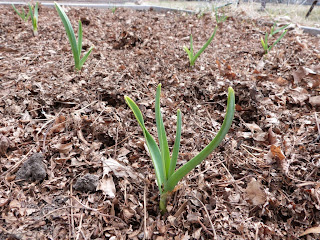Last year we planted 25 tiny strawberry plants in one of our garden boxes, which produced a handful of small berries. By now, they're another year older, and they've had a good rainy spring instead of last year's drought. As a result, the plants have really, well, perked up.
As you can see, we've chopped the berries into quarters, in preparation of making one of the our favorite strawberry items: fresh strawberry jam. Really, this is a simple thing to make, and it's a great way to experience the delicious flavor of these berries months after the harvest is over. The only other things you need are sugar, fruit pectin, and some canning jars. First, you mash up the berries a little to soften them up for the jam.
Then you bring the berries up to a boil, along with the pectin, mixed into about 1/4 cup of the sugar. Pectin is a totally natural product; it's the substance in plants that holds the cell walls together. It's extracted from fruit, and is readily available in grocery and hardware stores, near the canning supplies. As you might imagine, a substance that binds plants together is useful for setting up the gel that you expect in a jelly or jam. Some fruits have plenty of pectin within them, but strawberries are a little light so you have to add the packaged stuff. Here it is, coming up to a boil.
Once this has boiled, you stir in another 3 3/4 cups of sugar, return it to a boil, and boil for one full minute. At this point, there are ways to test for gel, but in our case it was quite noticeable while stirring that the jam was thickening. From here, the jam is simply ladled into clean warm canning jars, placed into a water batch canner, and processed for 10 minutes. That's it!
Once the jars have been pulled out and cooled, they're ready to enjoy whenever you want. For us, we have plenty of fresh strawberries to eat first before we want to crack one of these open, so we'll plan to store them for a little while before we dip into them. That's really no problem; in the sealed jars, the jam should stay fresh for at least a year and probably more. Of course, we did do a thorough job scraping our jam pot clean and tasting the little bit that didn't make it into the jars. It was delicious! In some ways, we can't wait til we get to open one of the finished jars.
This was such a fun project for us. We've canned fruit and jam several times before, often with purchased fruit, sometimes with fruit we picked ourselves, and once with fruit from Greg's Dad's trees. But this batch of strawberry jam marks the first time we've grown the fruit ourselves, picked it ourselves, and processed it into jam. This is homegrown, homemade, and home-canned. Having that kind of connection to our food is only going to make it taste that much better!
One final note, which we would be remiss in not mentioning. We frequently consult the Ball Blue Book for recipes and instruction on how to can, but our real reference guide is the website www.pickyourown.org. This site is an amazing one stop shop for finding pick-your-own farms and tons of canning recipes for how to preserve what you pick. If you have any interest in canning, we definitely recommend this site.
The first jam of 2013 is in the books. We'll see how many more we end up making before the growing season is over. Once you start canning, you just want to keep going!


































